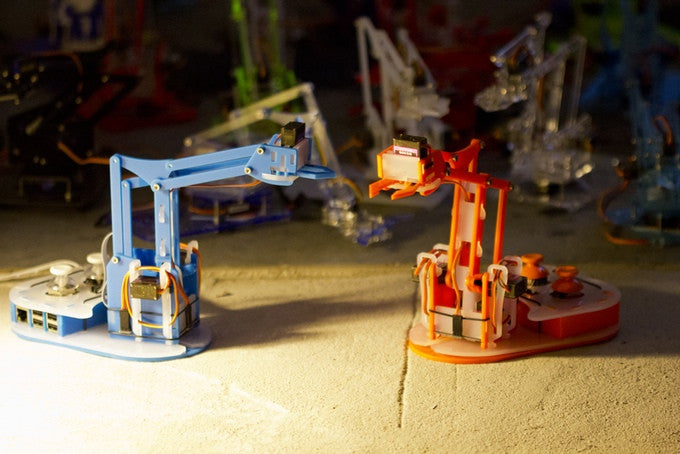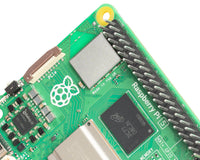
Raspberry Pi Roundup: a new robotic arm on Kickstarter, a thumb-played harp and micro:bits and Raspberry Pi used together
New Robotic Arm

At The Pi Hut, we really love the MeArm robotic arm. We've been selling it for ages. That's why we're really happy to support the latest version, which is specific to the Raspberry Pi, now available on Kickstarter. Let's give you a bit of background...
A couple of years ago, Ben Gray ran a highly successful Kickstarter campaign for the MeArm – a robotic arm. Now, he’s teamed up with Ben Pirt to form Mime Industries and to run a Kickstarter for the next generation of the MeArm – and as we said before, it's specifically designed to work with the Raspberry Pi!
The new version comes in blue or orange (you pick this later) and features a special HAT which sits on top of the Pi and provides two joysticks for control. The MeArm Pi is simpler than the previous version and comes with pre-calbrated servos, saving you that hassle, and is available from their Kickstarter page. You can get hold of one for the bargain price of £60. So, head over to the MeArm campaign page to find out more or watch the video below.
Thumb Harp

This tutorial, which is not for the beginner, uses wires of different lengths to create a thumb harp. An accelerometer is used to detect different vibrations caused by plucking the wires and an MCP3008 analog-to-digital converter chip is then used to translate the signals produced. These are fed into the Raspberry Pi which generates synthesized noises via ALSA based on the initial vibrations. The software is written in C. The tutorial is written in English and French and can be found here.
micro:bit Sequencer

David Whale (@whaleygeek), who some of you will know (he goes to a lot of events and does loads of outreach work, especially with micro:bit and the IET, and also runs a Raspberry Pi club in Harlow) and Jonny Austin, CTO of the micro:bit Foundation, have done an excellent project to show the micro:bit and the Raspberry Pi working together. They’ve built a rotunda, called a Tone Matrix, of 40 micro:bits representing a musical scale with each of 8 columns representing groups of notes on a pentatonic scale.
As the micro:bits are switched on, they communicate wirelessly with another micro:bit which is attached to a Raspberry Pi. The Pi then interprets which micro:bit(s) in the matrix are switched on and plays tones according to their positions. The whole thing then plays the notes in a loop, using Pygame for the individual ‘notes’ control. It is even possible to play a chord by turning on several micro:bits in a column.
I spoke to David about the project, and he explained it in-depth and told me that most of the actual computational work is done by the Pi – the micro:bits are essentially used as controllers.
"Jonny and I never met while working on this. We collaborated via Skype and Github the whole way. I tested the Pi code on a train and Jonny wrote the micro:bit code on a plane."
The laser-cut frame for the instrument was created at Cambridge Makespace.
You can see a video of it in action, at Bett, below (it runs from the beginning to about 3:45) and a slightly closer-up video of it via Twitter here. You can see all the code on Github here.





